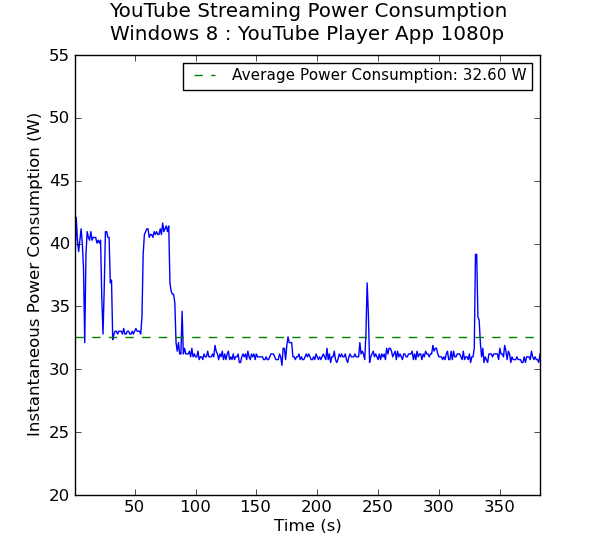Getting the Best out of an Ivy Bridge HTPC: Windows 8, madVR and More..
by Ganesh T S on January 20, 2013 3:00 PM EST- Posted in
- Home Theater
- Intel
- HTPC
- Ivy Bridge
- Windows 8
- Passive Cooling
Network Streaming Performance - YouTube
YouTube is one of the most popular video streaming services, and Google maintains a number of encodes for each stream. On platforms supporting Adobe Flash, FLV streams are available at resolutions ranging from 240p to 480p. HTML5 streams are either in WebM (for Firefox) or MP4 / H.264 (for Internet Explorer). WebM streams typically top out at 720p, while MP4 is the preferred format for 1080p. At higher resolutions, Adobe Flash also streams the MP4 version.
As expected, we get GPU acceleration when using Adobe Flash in Firefox on Windows 7. The debug OSD presents the requisite details.
HD YouTube Streaming using Adobe Flash in Mozilla Firefox on Windows 7
Windows 8 has an app for YouTube, 'YouTube Player' which allows for stream quality selection. Just like the Netflix app, there is no direct way to determine if GPU acceleration is being used.
HD YouTube Streaming using the YouTube Player App on Windows 8
We will rely on the power consumption at the wall to determine the efficiency of various ways to stream YouTube videos across different operating systems. Since the matrix of options is quite big, we present the graphs one at a time. All the graphs are on the same scale. Press the button below corresponding to the combination you want to compare the current graph against.

It can be seen that the Windows 8 YouTube Player App wins hands down. The stream being decoded is, in all probability, the 1080p H.264 version. Even when Adobe Flash is being used, Windows 8 seems to be more efficient compared to Windows 7. If you are on Windows, and prefer to use HTML5, it is better to avoid Mozilla Firefox because the WebM version consumes the most power at the wall (due to lack of hardware accelerated decode) while providing only a 720p stream. Once again, if YouTube forms a major part of your HTPC experience, an upgrade from Windows 7 to Windows 8 can be recommended.












138 Comments
View All Comments
iwayman1001 - Monday, January 21, 2013 - link
I think most if not all commenters here are completely missing the point on Jriver. Jriver can be your DLNA server, your media cloud server located in your own house. I've tried most MC software, WMC, TotalMedia, NextPVR, BeyondTV, XBMC, etc... None of them can be set up easily as media server cloud so that you can watch your live/recorded TV, all your ripped TV shows, movies, songs, etc over the Internet, your Android phones, your iPhone. You can watch your US live TV, your own movies, recorded TV shows, songs while you'r in Europe provided you have Internet access in the hotel or your smart phone. It take 5 minutes in Jriver to set that up after you build your home Jriver's media library. You do not have to know about public IP/private IP address, etc. Tryi it and you will find out all other MC servers are just for in home, not roaming on the road like Jriver provides.Monkeysweat - Monday, January 21, 2013 - link
were you using a RC candidate or last stable release (v.11)?ganeshts - Monday, January 21, 2013 - link
Frodo RC2However, I have seen the VC1 issue in previous stable builds too.
Iketh - Monday, January 21, 2013 - link
I haven't been able to respond to a post on this site for a couple months now. Can only make a new thread. I'm using IE9. When trying to reply to someone, it hangs with the working GIF twirling forever. Probably is related to the fact that I can't stay logged in from 1 page to the next either...Laststop311 - Tuesday, January 22, 2013 - link
Maybe I'm in the minority but I like an HTPC that can game as well. Yeah the htpc cases that can properly operate a full size high end gpu are bigger and louder. But with careful hardware choices and quality noctua fans you can make them nearly silent. You got to have a good furniture set up as well to make gaming with a wireless keyboard and mouse a reality. Proper high end gpu will give you better video playback in some situations as well.I can see a place for both. But I don't think ivy bridge is a good choice to jump in on the fanless htpc's. Haswell is perfectly suited for this application, power consumption lowered cpu performance and especially gpu performance increased greatly as this is a tock release which is always the best one. The Haswell version of this pc should run even cooler temps while providing better performance, especially on the gpu side (and intel better have fixed the 24hz bug)
gamoniac - Tuesday, January 22, 2013 - link
Thanks Ganesh, for comparing Win7 and Win8, and Metro vs Silverlight video rendering. I am surprised that the Netflix Metro apps are so much more efficient. Having just switched to Win8 two days ago, after reading this article, I checked and am able to confirm that on Win8, Netflix Metro app uses only 2% of my 6-core AMD 1090T CPU (on SSD), compared to the 8% of desktop IE10 browser (Silverlight), which is still better than Win7.Furthermore, the Metro Netflix app better renders in HD than in Silverlight, which periodically fails to render in HD for certain movies. Thanks again.
don_k - Tuesday, January 22, 2013 - link
I probably ask for this in just about every article in this, truly excellent, website so at the risk of becoming a broken record, could we please oh please have linux tests to go along with Windows on these things?HTPC, 'enterprise' product tests, file server type tests, all of these are simply incomplete without linux
testing without going into the reasons why as it will likely result in yet another flame war :)
I realise Linux isn't exactly your area of expertise but is it really that much more difficult to boot a linux based XBMC[1] live CD than it is to sit through yet another Windows installation?
Please consider doing this, I would love nothing more than to see Linux tests in my favourite hardware/review website.
http://mirrors.xbmc.org/releases/XBMCbuntu/xbmcbun...
ganeshts - Tuesday, January 22, 2013 - link
We definitely do Linux testing in our NAS reviews (using a CentOS guest OS). Also, my primary workplace m/c is RHEL 6 :)don_k - Monday, January 28, 2013 - link
Glad to hear it! :)So, are you going to be testing HTPCs with linux based XBMC or..?
coolhund - Tuesday, January 22, 2013 - link
Nice HTPC setup, but Windows 8? Really?How much did MS pay for that?